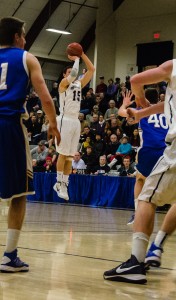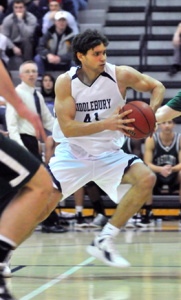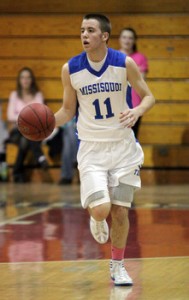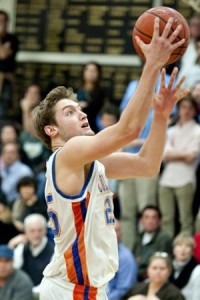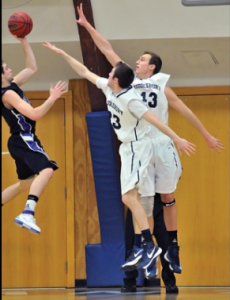Projected Conference Standings
1. Williams (10-0)
2. Amherst (9-1)
3. Middlebury (8-2)
4. Tufts (8-2)
5. Bowdoin (5-5)
6. Hamilton (4-6)
7. Bates (4-6)
8. Colby (3-7)
9. Connecticut College (2-8)
10. Trinity (2-8)
11. Wesleyan (0-10)
AMHERST LORD JEFFS
2013 record: 30-2, 10-0 (Conference Champions, National Champions)
 The Lord Jeffs have not lost a game since 2012. They went on the run of all runs through conference and tournament play last season, winning their last 24 games behind a prolific offense, a driven senior class, and individual improvement across the board. For Middlebury fans, it is easy to go back to that unforgettable February 12th night and wonder: if Willy Workman doesn’t tip in his own missed free throw to tie the game at the buzzer in double overtime (leading to a Middlebury win, as everyone but Workman thought they already had, and Amherst likely playing the conference tournament on the road) what might have changed? Sports hypotheticals are instructive but ultimately don’t matter. Amherst cruised the rest of the way (though the conference final came down to a game-saving Allen Williamson block), and nobody would dispute that on the whole they played the best of any team in the country in 2013. Amherst was the class of the nation and their championship felt anything but fluky, which is saying a lot given the random nature of college basketball tournament play. That said, the Lord Jeffs lose three (arguably still underrated) senior stars in Workman, Williamson, and Pete Kaasila. Workman was an all-around star — a shooter, rebounder, passer, ball-handler, defender, and leader. Williamson was a complementary player whose athleticism outshined his performance until the final stretch of 2013, when he became the best player on the team, putting up 16.1 points and 7.4 rebounds on 54% shooting in postseason play. Kaasila was an unmovable rock down low who had a knack for scoring when the team needed it, and led the conference with a 64% field goal mark. When considering Amherst’s 2014 prospects, it is important to temper expectations by appreciating how well that senior class played last season.
The Lord Jeffs have not lost a game since 2012. They went on the run of all runs through conference and tournament play last season, winning their last 24 games behind a prolific offense, a driven senior class, and individual improvement across the board. For Middlebury fans, it is easy to go back to that unforgettable February 12th night and wonder: if Willy Workman doesn’t tip in his own missed free throw to tie the game at the buzzer in double overtime (leading to a Middlebury win, as everyone but Workman thought they already had, and Amherst likely playing the conference tournament on the road) what might have changed? Sports hypotheticals are instructive but ultimately don’t matter. Amherst cruised the rest of the way (though the conference final came down to a game-saving Allen Williamson block), and nobody would dispute that on the whole they played the best of any team in the country in 2013. Amherst was the class of the nation and their championship felt anything but fluky, which is saying a lot given the random nature of college basketball tournament play. That said, the Lord Jeffs lose three (arguably still underrated) senior stars in Workman, Williamson, and Pete Kaasila. Workman was an all-around star — a shooter, rebounder, passer, ball-handler, defender, and leader. Williamson was a complementary player whose athleticism outshined his performance until the final stretch of 2013, when he became the best player on the team, putting up 16.1 points and 7.4 rebounds on 54% shooting in postseason play. Kaasila was an unmovable rock down low who had a knack for scoring when the team needed it, and led the conference with a 64% field goal mark. When considering Amherst’s 2014 prospects, it is important to temper expectations by appreciating how well that senior class played last season.
The Lord Jeffs are ranked 1st in the 2014 preseason D3Hoops.com Top 25 Poll, but probably shouldn’t be. No team can lose that much talent and bounce back to the top that easily. That said, Amherst returns a lot of talent. It starts with Aaron Toomey, the senior point guard with a complete offensive game. Toomey averaged 17.3 points per game last season on 44/42/89 shooting, to go along with 4.8 rebounds and 5 assists. Toomey’s style of play translates well to his new role as a score-first creator. He will be asked to take more shots this season and to create his shot more often, a role in which he will likely thrive, though it will test his durability. Around Toomey there is a ton of talent but little in the way of proven commodities. Connor Green, a 6’4” guard, averaged 9.3 points per game as a freshman, and could be Amherst’s next offensive star. He has a nice outside shot to go along with strong finishing ability at the rim. Green displayed his improvement over the course of the season in the national championship game, scoring 16 points on 5 of 9 shooting, knocking down a pair of threes and finishing at the rim. Joining those two in the starting backcourt will be David Kalema, a senior point guard sharpshooter who scored 9.0 points per game on 48/44/66 shooting last season. Another guard in the picture is Tom Killian, who started last year but is less efficient offensively than the other three. A lanky 6’4”, Killian will be a big part of the rotation but needs to improve on his 40/36/88 shooting splits to surpass Green and Kalema for more minutes. Together those four form an extremely talented offensive backcourt, and each will be asked to carry more of the scoring load this season. The major question is whether any or all of the complementary three can maintain their efficiency and effectiveness in a higher usage role. We project Green to take the biggest jump of the group, possibly finishing in the top 10 in the conference in points per game.
The frontcourt is more of an unknown for the Lord Jeffs, as the top returner is sophomore Ben Pollack. We like what we have seen from Pollack, as he averaged 4.3 points, 3.6 rebounds, and 0.8 blocks in 13 minutes per game last season. Asking him to go from the fourth best forward to the top forward in one year will be hard though, as he will no longer be a secondary concern for opposing defenses. Around him is a slew of unproven talent, from upperclassmen Joe Mussachia to a very talented freshman class, including six players at or above 6’4.” The freshman class is led by the 6’8” David George, who projects to secure a role immediately. The fate of Amherst’s season likely depends on whether a couple of those unknown bigs can contribute at a plus level. Last year, Amherst’s complementary players showed drastic offseason improvement across the board. If they experience similar progress this year, it will be enough to carry Amherst to its third consecutive NESCAC title.
Matching up
Sunday, February 16, 4 pm, Middlebury at Amherst
Last year: 104-101 Amherst (3 OT)
It is fitting that Joey Kizel and Aaron Toomey end their final regular season playing on the same court. Two all-time great NESCAC guards, and the two best guards in the country according to D3Hoops.com, Kizel and Toomey have gone back and forth in epic battles over the past three years. From Kizel’s comeback-sparking steals against Toomey to Toomey’s game-winning plays, these games have not been short on memorable moments. So that’s where our immediate focus will be in this matchup, but while we can count on great games from both point guards, this one will likely be decided by their supporting casts. This late season matchup will be an indicator of which team did a better job of transitioning its talent into a competitive product. As it has the past two years, this game could determine tournament hosting rights.
2013-14 Predicted Winner: Amherst
•••
BATES BOBCATS
2013 record: 10-15, 5-5 (lost in conference quarterfinals)
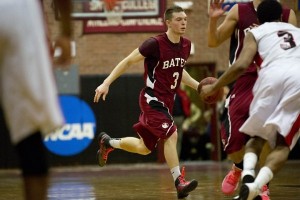 After making a NESCAC semifinals appearance in 2012, there were some expectations for a bigger year from Bates, but those faded when they lost six non-conference games before January. Bates ended up finishing respectably, led by their conference-leading defense (63.7 ppg allowed), but will have to replace two of their top scorers in forward Ed Bogdanovic (13.4 ppg, 7.3 rpg, 46% FG) and guard Mark Brust (10.0 ppg, 4.1 rpg, 2.9 apg). The returners are led by Luke Matarazzo, a slippery quick point guard who can score (10.8 ppg, 35/34/82 shooting). He is flanked by two talented wing players who both have the potential to be stars: junior Graham Safford (pictured right) and sophomore Mike Boornazian. Safford is most likely to be the feature scorer, as he averaged 11.7 points per game on 42/41/67 shooting last season. Boornazian is bigger, but less dynamic with the ball in hands. Outside of those three, Bates’ top returning scorers are Billy Selmon and Sean Cunningham (7.0 combined points in 30.6 combined minutes per game), which leads to the question: who do the Bobcats start down low? In fact, Bates doesn’t have a single forward or center remaining on its roster who scored a point last season. Freshmen brothers Marcus and Malcolm Delpeche, 6’7” and 6’8” respectively, will get big time opportunities early and could determine this team’s fate. It is likely that the Bobcats go with a four-guard rotation fairly often and hope that at least one of the recruits can jump in quickly. The key for Bates this season is going to be setting the tempo and playing aggressive defense. If it turns into a half-court game, their lack of front court polish will be exposed.
After making a NESCAC semifinals appearance in 2012, there were some expectations for a bigger year from Bates, but those faded when they lost six non-conference games before January. Bates ended up finishing respectably, led by their conference-leading defense (63.7 ppg allowed), but will have to replace two of their top scorers in forward Ed Bogdanovic (13.4 ppg, 7.3 rpg, 46% FG) and guard Mark Brust (10.0 ppg, 4.1 rpg, 2.9 apg). The returners are led by Luke Matarazzo, a slippery quick point guard who can score (10.8 ppg, 35/34/82 shooting). He is flanked by two talented wing players who both have the potential to be stars: junior Graham Safford (pictured right) and sophomore Mike Boornazian. Safford is most likely to be the feature scorer, as he averaged 11.7 points per game on 42/41/67 shooting last season. Boornazian is bigger, but less dynamic with the ball in hands. Outside of those three, Bates’ top returning scorers are Billy Selmon and Sean Cunningham (7.0 combined points in 30.6 combined minutes per game), which leads to the question: who do the Bobcats start down low? In fact, Bates doesn’t have a single forward or center remaining on its roster who scored a point last season. Freshmen brothers Marcus and Malcolm Delpeche, 6’7” and 6’8” respectively, will get big time opportunities early and could determine this team’s fate. It is likely that the Bobcats go with a four-guard rotation fairly often and hope that at least one of the recruits can jump in quickly. The key for Bates this season is going to be setting the tempo and playing aggressive defense. If it turns into a half-court game, their lack of front court polish will be exposed.
Matching up
Friday, January 10, 8 pm, Bates at Middlebury
Last year: 59-56 Middlebury
The Bates-Middlebury game last year was ugly at times, which is a reflection of Bates controlling the tempo. Their guards are pestering, and this game means that Joey Kizel’s new backcourt mates will be tested early in conference play. Though Bates can be exploited in the half court, the Panthers might not have a half court-identity this year given the relationship between athleticism (lots) and post skills (few) on the team. That said, you can take advantage of height disparities in more ways than half-court post sets. Expect Middlebury to get Dylan Sinnickson and Matt Daley facing the basket in the mid-range, and Hunter Merryman shooting over defenders on the outside. If Middlebury loses its NESCAC home opener vs. Bates, it could be a long season.
2013-14 Predicted Winner: Middlebury
•••
BOWDOIN POLAR BEARS
2013 record: 14-10, 5-5 (lost in conference quarterfinals)
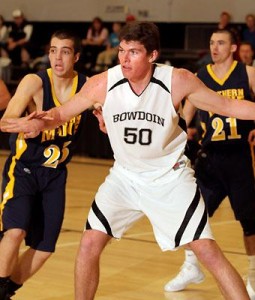 Bowdoin was on track for a big jump this year before a summer injury to star point guard Bryan Hurley put his entire season in jeopardy. The rest of the team has plenty of talent, but Hurley was the distributor who made it all come together, averaging 8.3 assists per game, the second best mark in all of Division III. Hurley’s absence raises several questions. First, how valuable was he to Bowdoin’s success? Can the talented players around Hurley make up for his absence, or was the offense predicated on his unique ball distribution abilities? Our guess is that Bowdoin would have competed with the top tier in the conference this year with Hurley (with a good shot of sneaking into the semifinals), but his absence will put some distance between them and Williams, Amherst, Tufts, and Middlebury.
Bowdoin was on track for a big jump this year before a summer injury to star point guard Bryan Hurley put his entire season in jeopardy. The rest of the team has plenty of talent, but Hurley was the distributor who made it all come together, averaging 8.3 assists per game, the second best mark in all of Division III. Hurley’s absence raises several questions. First, how valuable was he to Bowdoin’s success? Can the talented players around Hurley make up for his absence, or was the offense predicated on his unique ball distribution abilities? Our guess is that Bowdoin would have competed with the top tier in the conference this year with Hurley (with a good shot of sneaking into the semifinals), but his absence will put some distance between them and Williams, Amherst, Tufts, and Middlebury.
Senior captains Andrew Madlinger and Matt Matthias are both guards, and will likely take some time at the point, but are used to playing off the ball. Madlinger is an unsung star, averaging 14.3 points per game on 45/42/86 shooting last year. Matthias was similarly efficient (45/42/70) though less proficient (8.4 points per game). The third best offensive weapon will likely be Keegan Pieri, a 6’6” forward who averaged 13.3 points on 50% FG shooting last season. Madlinger, Matthias, and Pieri are going to have to grow accustomed to creating their own shots more, and whether they do so successfully will tell us a lot about their games. The last player to keep an eye on for Bowdoin is John Swords (shown above), the 7’0” center who will be intriguing as long as he remains 7’0” tall. Swords averaged 6.1 points in 15 minutes per game last season, and his peripheral statistics suggest he could be one of the conference’s better big men if he played more minutes. Big centers like Swords mature late, so don’t be surprised if he turns into a force and Bowdoin forges a new identity around an efficient Swords and the scoring wings around him.
Matching up
Sunday, February 9, 4 pm, Bowdoin at Middlebury
Last year: 72-61 Middlebury
You would think that combination of Jack Roberts and Chris Churchill would be the best antidote in the conference for John Swords, but he scored 14 points on 6-6 FG shooting in last year’s matchup. If he is a focal point in the offense by this matchup, Middlebury’s ‘5s’ will have to step up. Outside of that matchup, Middlebury simply has a more complete and talented team than Bowdoin, and should be able to dictate the style of play and execute better than the Polar Bears.
2013-14 Predicted Winner: Middlebury
•••
COLBY MULES
2013 record: 7-17, 3-7 (lost in conference quarterfinals)
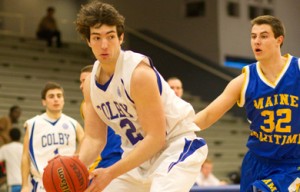 If Bowdoin struggles without Hurley, don’t sleep on Colby as the darkhorse winner of the Maine rivalry this year. The Mules return seven of their top eight scorers from last year, and seem to have a good foundational piece in sophomore Chris Hudnut (seen right). Hudnut, a 6’8” center, averaged 12.3 points and 5.3 rebounds in 23 minutes per game last season as a freshman, on a respectable 45% FG shooting. NESCAC centers practically never step into immediate success like Hudnut did last season (a helpful comparison might be Ryan Sharry’s rookie year: 7.7 ppg, 5.4 rpg, 57% FG, 18 mpg), so his performance rightfully has turned some heads. Hudnut was given a lot of touches in a program depleted of talent however, so it’s unclear how much of his production was based on skill as opposed to opportunity. Outside of Hudnut, the most exciting player in Waterville is fellow sophomore Patrick Stewart. The 6’6” forward averaged 7.5 points and 6.7 rebounds on 50/41/75 shooting last season. If Hudnut and Stewart continue to improve, they could form one of the better frontcourts in the conference. What this season will really tell us about Colby is whether they should be on our radar as a top tier contender in a year or two. If Hudnut, Stewart, and the young core around them show that they have committed to the program and have the talent and work ethic to make major strides in their games over the offseason, it will indicate that Colby’s infusion of youth is part of something significant for their future as a NESCAC contender.
If Bowdoin struggles without Hurley, don’t sleep on Colby as the darkhorse winner of the Maine rivalry this year. The Mules return seven of their top eight scorers from last year, and seem to have a good foundational piece in sophomore Chris Hudnut (seen right). Hudnut, a 6’8” center, averaged 12.3 points and 5.3 rebounds in 23 minutes per game last season as a freshman, on a respectable 45% FG shooting. NESCAC centers practically never step into immediate success like Hudnut did last season (a helpful comparison might be Ryan Sharry’s rookie year: 7.7 ppg, 5.4 rpg, 57% FG, 18 mpg), so his performance rightfully has turned some heads. Hudnut was given a lot of touches in a program depleted of talent however, so it’s unclear how much of his production was based on skill as opposed to opportunity. Outside of Hudnut, the most exciting player in Waterville is fellow sophomore Patrick Stewart. The 6’6” forward averaged 7.5 points and 6.7 rebounds on 50/41/75 shooting last season. If Hudnut and Stewart continue to improve, they could form one of the better frontcourts in the conference. What this season will really tell us about Colby is whether they should be on our radar as a top tier contender in a year or two. If Hudnut, Stewart, and the young core around them show that they have committed to the program and have the talent and work ethic to make major strides in their games over the offseason, it will indicate that Colby’s infusion of youth is part of something significant for their future as a NESCAC contender.
Matching up
Friday, February 7, 8 pm, Colby at Middlebury
Last year: 85-62 Middlebury
Last year’s matchup was a blowout, as Colby’s interior defense was exposed. Middlebury bigs Pete Lynch, Jack Roberts, Matt Daley, Jake Nidenberg, and James Jensen combined to shoot 20-29 from the field. While the Colby defense should be improved, enough of the Panthers listed above will be too. This one might be tougher than last year’s, but it will take at least another year before Colby can seriously challenge this caliber of team.
2013-14 Predicted Winner: Middlebury
•••
CONNECTICUT COLLEGE CAMELS
2013 record: 7-16, 0-10
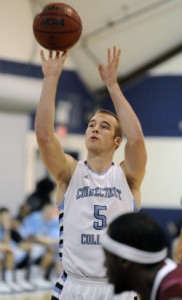 Senior Matt Vadas, a somewhat under-the-radar scoring sensation, averaged 20.2 points per game last season, and is on pace to become Connecticut College’s all-time points leader by season’s end. Vadas’ scoring numbers are not totally contingent on an offense with nowhere else to go, either. He shot a respectable 41/41/77 line and added 7.5 rebounds and 1.4 steals per game last year (compare to Aaron Toomey’s 44/42/89, fewer points, fewer rebounds, and fewer steals), which suggests he is an elite scorer. The problem in New London is that Vadas’s supporting cast is weak. Last year’s star freshman, Jared Schill, has left the program, and that leaves 6’5” sophomore Aaron McBurnie (7.6 ppg, 42% FG) as the top returning scorer. However, senior guard Rob Harrigan returns after a year away from the program. As a sophomore, he led the conference in minutes per game and scored 8.8 points per game, shooting a very efficient 44/45/89. If Schill were still in the mix, Harrigan and Vadas would form a potent wing duo, but with the Camels lacking an established ball handler, their scoring abilities will likely not be maximized. Outside of McBurnie and Harrigan, two seniors, Mason Lopez and Tyrone Turner, with mediocre production but good efficiency are likely to flank Vadas in the Camel offense. Lopez is a smooth-shooter who shot 45/45/80 last year, putting up 7.2 points per game, while Turner shot 47% from the floor but only scored 5.3 points per game. If the Camels are going to make something of 2014 and Matt Vadas’s career, it is going to take Harrigan’s resurgence, a big jump from McBurnie down low, and the surprise emergence of either a distributor or one of their three 6’5” or taller freshman forwards. Otherwise, Vadas isn’t the style of scorer who can will his team to victory — he scores a lot, but we’ve never seen him “take over a game,” which is a distinction worth making — so don’t expect the Camels to make much noise in conference play this year.
Senior Matt Vadas, a somewhat under-the-radar scoring sensation, averaged 20.2 points per game last season, and is on pace to become Connecticut College’s all-time points leader by season’s end. Vadas’ scoring numbers are not totally contingent on an offense with nowhere else to go, either. He shot a respectable 41/41/77 line and added 7.5 rebounds and 1.4 steals per game last year (compare to Aaron Toomey’s 44/42/89, fewer points, fewer rebounds, and fewer steals), which suggests he is an elite scorer. The problem in New London is that Vadas’s supporting cast is weak. Last year’s star freshman, Jared Schill, has left the program, and that leaves 6’5” sophomore Aaron McBurnie (7.6 ppg, 42% FG) as the top returning scorer. However, senior guard Rob Harrigan returns after a year away from the program. As a sophomore, he led the conference in minutes per game and scored 8.8 points per game, shooting a very efficient 44/45/89. If Schill were still in the mix, Harrigan and Vadas would form a potent wing duo, but with the Camels lacking an established ball handler, their scoring abilities will likely not be maximized. Outside of McBurnie and Harrigan, two seniors, Mason Lopez and Tyrone Turner, with mediocre production but good efficiency are likely to flank Vadas in the Camel offense. Lopez is a smooth-shooter who shot 45/45/80 last year, putting up 7.2 points per game, while Turner shot 47% from the floor but only scored 5.3 points per game. If the Camels are going to make something of 2014 and Matt Vadas’s career, it is going to take Harrigan’s resurgence, a big jump from McBurnie down low, and the surprise emergence of either a distributor or one of their three 6’5” or taller freshman forwards. Otherwise, Vadas isn’t the style of scorer who can will his team to victory — he scores a lot, but we’ve never seen him “take over a game,” which is a distinction worth making — so don’t expect the Camels to make much noise in conference play this year.
Matching up
Sunday, January 19, 4 pm, Middlebury at Connecticut College
Last year: 85-68 Middlebury
Matt Vadas is 7-30 from the field in his career against Middlebury. That is what Nolan Thompson did to opposing scorers (in fact, Vadas’ most successful game vs. the Panthers came when Thompson was returning from his 2012 absence and came off the bench). This season we might get to see the Vadas that has had major success against other opponents over the past three years. By this point in January, we should probably have a good feel for who Jeff Brown relies on as a defender for players like Vadas. The best two-guard defender on the team right now is probably Nate Bulluck, though a Jake Brown, Connor Huff, or James Jensen could come out of position to guard Vadas. It probably will not matter, though, because whether or not Vadas wins his matchup, the Camels cannot stack up with the rest Middlebury’s rotation.
•••
HAMILTON CONTINENTALS
2013 record: 12-12, 3-7
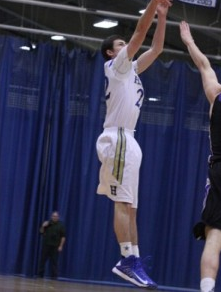 After Joey Kizel and Aaron Toomey, Hamilton sophomore Matt Hart (right) be the best guard in the conference this season. Ultimately, we think Daniel Wohl is more valuable given his contributions on the defensive end, but Hart is the more dangerous offensive player. As a freshman, he averaged 15.3 points per game on 44/37/85 shooting, to go along with strong peripherals. His primary weapon is his mid-range and three-point jumper, which he can hit with little separation because of his high release point. Hart could be the NESCAC’s next All-American guard if he continues developing on his current projection. Last year’s second and third top scorers also return: Greg Newton, a senior point guard who scored 10.5 points per game on an efficient 45/42/78 shooting line, and Peter Kazickas, an undersized forward who shot 54% from the field and scored 7.6 points per game. Joseph Lin, younger brother of Houston Rockets point guard Jeremy Lin, needs to add bulk to his 5’11,” 135 pound frame, but will get rotation minutes after averaging 4.4 points per game last season.
After Joey Kizel and Aaron Toomey, Hamilton sophomore Matt Hart (right) be the best guard in the conference this season. Ultimately, we think Daniel Wohl is more valuable given his contributions on the defensive end, but Hart is the more dangerous offensive player. As a freshman, he averaged 15.3 points per game on 44/37/85 shooting, to go along with strong peripherals. His primary weapon is his mid-range and three-point jumper, which he can hit with little separation because of his high release point. Hart could be the NESCAC’s next All-American guard if he continues developing on his current projection. Last year’s second and third top scorers also return: Greg Newton, a senior point guard who scored 10.5 points per game on an efficient 45/42/78 shooting line, and Peter Kazickas, an undersized forward who shot 54% from the field and scored 7.6 points per game. Joseph Lin, younger brother of Houston Rockets point guard Jeremy Lin, needs to add bulk to his 5’11,” 135 pound frame, but will get rotation minutes after averaging 4.4 points per game last season.
Matching up
Sunday, February 2, 4 pm, Middlebury at Hamilton
Last year: 66-47 Middlebury
Last year’s win was all about Nolan Thompson. The senior scored 18 points on 7-10 shooting, notched his career 1,000th point, and his shut down perimeter defense helped Middlebury limit the Continentals to 47 points, the lowest scoring output for a regular season opponent since 2000. This year will be different, as Hamilton comes back at full strength to host Middlebury sans Thompson. We expect this to be a close matchup, one in which Middlebury will attempt to push the tempo to exploit an athletic advantage, and likely pull away with the win.
2013-14 Predicted Winner: Middlebury
•••
TRINITY BANTAMS
2013 record: 9-15, 2-8
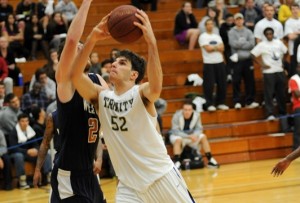 Trinity returns their top four scorers from last season, as the Bantam roster was underclassman-heavy to the extreme in 2012-13. To that point, only Mick Distasio departs due to graduation, and there are no current seniors on this year’s roster. Trinity’s roster is built around two very talented sophomores, Jaquann Starks and Shay Ajayi. Starks, a 5’9” guard, led the team with 10.6 points per game last year, on 42/45/84 shooting. Ajayi is a long 6’5” and has high upside, already producing last year with 8.2 points and 5.5 rebounds per game. Both could be in all-conference range at least by next year. Down low for the Bantams is the 6’8” junior George Papadeas (right), who averaged 7.4 points and 5.1 rebounds per game last season. Papadeas is one of the more intriguing scorers in the league, because he produced those numbers in a limited 15 minutes per game. He should be tested in a bigger role in 2014.
Trinity returns their top four scorers from last season, as the Bantam roster was underclassman-heavy to the extreme in 2012-13. To that point, only Mick Distasio departs due to graduation, and there are no current seniors on this year’s roster. Trinity’s roster is built around two very talented sophomores, Jaquann Starks and Shay Ajayi. Starks, a 5’9” guard, led the team with 10.6 points per game last year, on 42/45/84 shooting. Ajayi is a long 6’5” and has high upside, already producing last year with 8.2 points and 5.5 rebounds per game. Both could be in all-conference range at least by next year. Down low for the Bantams is the 6’8” junior George Papadeas (right), who averaged 7.4 points and 5.1 rebounds per game last season. Papadeas is one of the more intriguing scorers in the league, because he produced those numbers in a limited 15 minutes per game. He should be tested in a bigger role in 2014.
Matching up
Friday, February 14, 8 pm, Middlebury at Trinity
Last year: 66-59 Middlebury
Last year’s game was too close for comfort, as Starks, Ajayi, and Papadeas all put up double figures, and Middlebury struggled from the field (41%). One matchup of intrigue this year might be Jake Brown vs. Jaquann Starks, as the Middlebury freshman, if he gets rotation minutes (we think he will), is the only player on the roster with the quickness to shut down Starks. As for Ajayi, he might see more of Jensen, who can match him athletically and outmatch him physically.
•••
TUFTS JUMBOS
2013 record: 17-9, 7-3 (lost conference semifinals)
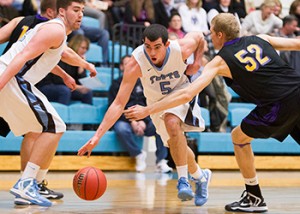 The Jumbos’ 2014 prospects took a major hit this offseason when they learned that rising sophomore center Tom Palleschi would no longer be able to play for health reasons. Palleschi, the 2013 NESCAC Rookie of the Year, was a rising star. A physical center with a developing offensive skillset, Palleschi averaged 10.0 points, 6.0 rebounds, and 1.7 blocks per game as a freshman. During conference play, he averaged a dominant 13.7 points per game on 57% shooting. Without Palleschi, Tufts still boasts one of the most talented rosters in the conference. Ben Ferris (right) is an efficient shooting guard who scored 13.3 points per game on 49/44/78 shooting last year. He is supported by dynamic wingman Stephen Haladyna, a 6’5” sophomore with athleticism and plus shooting (52/44/81). Two veteran guards will likely share ball-handling duties in Kwame Firempong and Oliver Cohen. Neither is a strong scorer, but they can distribute (2.8 and 3.6 assists per game, respectively). Both played starter minutes last year, but we expect freshman Tarik Smith to chip into their playing time this upcoming season. Smith is a potential star who will likely arrive game-ready, but he is not Tufts’ most highly touted recruit. That distinction belongs to 6’8” Hunter Sabety, who will be asked to take Palleschi’s role in the offense, and upon whose performance the Jumbos’ fate likely hinges. Because of Smith and Sabety, Tufts has the talent to compete for a NESCAC title and make a run in the NCAA Tournament. Even without Palleschi, this is an up-and-coming program that will probably make its presence known nationally in 2014.
The Jumbos’ 2014 prospects took a major hit this offseason when they learned that rising sophomore center Tom Palleschi would no longer be able to play for health reasons. Palleschi, the 2013 NESCAC Rookie of the Year, was a rising star. A physical center with a developing offensive skillset, Palleschi averaged 10.0 points, 6.0 rebounds, and 1.7 blocks per game as a freshman. During conference play, he averaged a dominant 13.7 points per game on 57% shooting. Without Palleschi, Tufts still boasts one of the most talented rosters in the conference. Ben Ferris (right) is an efficient shooting guard who scored 13.3 points per game on 49/44/78 shooting last year. He is supported by dynamic wingman Stephen Haladyna, a 6’5” sophomore with athleticism and plus shooting (52/44/81). Two veteran guards will likely share ball-handling duties in Kwame Firempong and Oliver Cohen. Neither is a strong scorer, but they can distribute (2.8 and 3.6 assists per game, respectively). Both played starter minutes last year, but we expect freshman Tarik Smith to chip into their playing time this upcoming season. Smith is a potential star who will likely arrive game-ready, but he is not Tufts’ most highly touted recruit. That distinction belongs to 6’8” Hunter Sabety, who will be asked to take Palleschi’s role in the offense, and upon whose performance the Jumbos’ fate likely hinges. Because of Smith and Sabety, Tufts has the talent to compete for a NESCAC title and make a run in the NCAA Tournament. Even without Palleschi, this is an up-and-coming program that will probably make its presence known nationally in 2014.
Matching up
Sunday, January 12, 4 pm, Tufts at Middlebury
Last year: 70-69 Middlebury
Middlebury has never seen the real Ben Ferris, because he has always been unable to get out from under Nolan Thompson’s smothering defense. Ferris has 8 points and 2 made field goals in his career against the Panthers. This year, Ferris will likely be the center of the offense, which will make it that much more difficult to stop Haladyna, Sabety, and company. This is going to be Middlebury’s biggest challenge of the first half of conference play, and could have a major say in conference tournament seeding. Don’t be surprised if Tufts claims its first win against the Panthers since 2006.
2013-14 Predicted Winner: Middlebury
•••
WESLEYAN CARDINALS
2013 record: 12-13, 4-6 (lost conference quarterfinals)
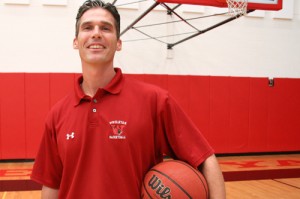 Believe it or not, last year’s mediocre Wesleyan team came into the season nationally-ranked and expected to challenge Amherst and Middlebury for the conference title. They returned three eventual 1,000-point scorers in their senior class, and had lost in the conference semifinals the year before. What happened? The seniors regressed and played inconsistently, and nobody filled the depth roles behind them. It was a poor reflection on the program, and leaves them in an ugly place headed into 2014. A sub-.500 team without its top three returning scorers cannot compete in this conference. Making matters worse is the departure of two underclassmen, Julian Harris and Avery Robinson, who would have projected into starting roles. Forwards Glen Thomas and Rashid Epps are the best returners, but the two forwards combined for a mere 9.7 points per game last season. Bryan Bartner is a great outside shooter but has no other plus skills. The biggest bright spot is highly touted recruit Harry Rafferty, who will almost certainly start at point guard from day one. Rafferty can’t be expected to carry the team out of mediocrity, though. It’s going to be a long season in Middletown.
Believe it or not, last year’s mediocre Wesleyan team came into the season nationally-ranked and expected to challenge Amherst and Middlebury for the conference title. They returned three eventual 1,000-point scorers in their senior class, and had lost in the conference semifinals the year before. What happened? The seniors regressed and played inconsistently, and nobody filled the depth roles behind them. It was a poor reflection on the program, and leaves them in an ugly place headed into 2014. A sub-.500 team without its top three returning scorers cannot compete in this conference. Making matters worse is the departure of two underclassmen, Julian Harris and Avery Robinson, who would have projected into starting roles. Forwards Glen Thomas and Rashid Epps are the best returners, but the two forwards combined for a mere 9.7 points per game last season. Bryan Bartner is a great outside shooter but has no other plus skills. The biggest bright spot is highly touted recruit Harry Rafferty, who will almost certainly start at point guard from day one. Rafferty can’t be expected to carry the team out of mediocrity, though. It’s going to be a long season in Middletown.
Matching up
Friday, January 17, 8 pm, Middlebury at Wesleyan
Last year: 78-77 Middlebury (OT), 61-49 Middlebury (Conference quarterfinals)
Mike Callaghan and Shasha Brown were tough matchups for Middlebury last year, at times. The Panthers will prefer to play the younger, less talented Cardinals squad that hosts them in mid-January. As long as Rafferty hasn’t turned his teammates from water to wine in two months, this will be one of many conference losses for Wesleyan.
2013-14 Predicted Winner: Middlebury
•••
WILLIAMS EPHS
2013 record: 26-5, 9-1 (lost conference finals, lost national quarterfinals)
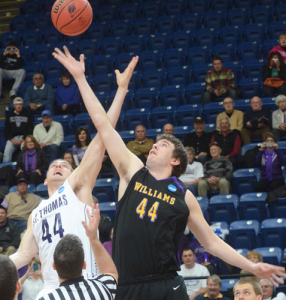 The 2014 Ephs are a masterpiece. We said prior to last season that Williams was drastically underrated (most observers actually had Williams finishing fourth or fifth in the conference) and predicted that they would finish in the top 10 in the nation. The Ephs came through with conference final and national quarterfinal appearances. This year, they bring back an incredibly talented roster, led by two of the best seniors in the country, Michael Mayer (right) and Taylor Epley. Mayer, 6’9,” is a preseason favorite for Conference and National Player of the Year, coming off of a season in which he posted a superstar line: 17.7 ppg, 8.8 rpg, 2.3 apg, 1.2 bpg, and 57/37/76 shooting. Mayer is very skilled for a player his size, a capable ball-handler and passer with an array of post moves and very soft touch around the basket, to go along with an improving three-point shot. If Williams decides to lean on him more, Mayer could have a monster senior season. Epley is a pure scorer, a 6’4” lefty with tremendous range and a nice ability to finish near the basket. He scored 18.5 points per game last season on 50/43/84 shooting, and is underrated as a defender. Then there’s Daniel Wohl, one of our favorite players to watch in the conference, a lanky, athletic, 6’6” guard/forward who started to really put it together last year. His final stats, 10.2 points per game, 5.5 rebounds per game, and 53/42/69 shooting, do not reflect his realizable potential. Wohl could be a Willy Workman type presence for the Ephs this year. Senior John Weinheimer and junior Hayden Rooke-Ley are likely to be the other starters. Weinheimer scored 4.4. points in 17 minutes per game last season, while Rooke-Ley missed all of last season but was a sharp scorer (7.0 points on 46/44/90 shooting) off the bench as a freshman.
The 2014 Ephs are a masterpiece. We said prior to last season that Williams was drastically underrated (most observers actually had Williams finishing fourth or fifth in the conference) and predicted that they would finish in the top 10 in the nation. The Ephs came through with conference final and national quarterfinal appearances. This year, they bring back an incredibly talented roster, led by two of the best seniors in the country, Michael Mayer (right) and Taylor Epley. Mayer, 6’9,” is a preseason favorite for Conference and National Player of the Year, coming off of a season in which he posted a superstar line: 17.7 ppg, 8.8 rpg, 2.3 apg, 1.2 bpg, and 57/37/76 shooting. Mayer is very skilled for a player his size, a capable ball-handler and passer with an array of post moves and very soft touch around the basket, to go along with an improving three-point shot. If Williams decides to lean on him more, Mayer could have a monster senior season. Epley is a pure scorer, a 6’4” lefty with tremendous range and a nice ability to finish near the basket. He scored 18.5 points per game last season on 50/43/84 shooting, and is underrated as a defender. Then there’s Daniel Wohl, one of our favorite players to watch in the conference, a lanky, athletic, 6’6” guard/forward who started to really put it together last year. His final stats, 10.2 points per game, 5.5 rebounds per game, and 53/42/69 shooting, do not reflect his realizable potential. Wohl could be a Willy Workman type presence for the Ephs this year. Senior John Weinheimer and junior Hayden Rooke-Ley are likely to be the other starters. Weinheimer scored 4.4. points in 17 minutes per game last season, while Rooke-Ley missed all of last season but was a sharp scorer (7.0 points on 46/44/90 shooting) off the bench as a freshman.
Behind those two is a lot of talent, starting with Duncan Robinson, a phenomenally talented freshman with Division I length and shooting range. Robinson was touted by some as the best non-Division I player in his recruiting class, after his performance and growth this past season turned heads. This year, it is reasonable to expect the 6’7” guard to play around 20 minutes per game and take (and make) a ton of threes. Also in the mix off the bench are point guards Luke Thoreson and Mike Greenman, both of whom will compete for playing time behind Rooke-Ley. Finally, there is Ryan Kilcullen, the 6’7” junior forward who transferred from Boston College before last season and who would probably be one of the more hyped players in any other program. Kilcullen is talented and should contribute as the top front-court reserve.
Because the talent is overwhelming in Williamstown, it is easy to overlook some potential problem areas, but sports are always more complicated than a superficial preview suggests, so it is worth considering some possible sources of trouble for the Ephs. In other words, what might stop this team, which we believe to be head and shoulders above the rest of the conference, from winning the conference and reaching the national title game? Besides the obvious caveat for injuries, one concern is that this group of players is a little short on big game experience because of their down 2012 season. Epley and Rooke-Ley were contributors to the 2011 Final Four team, but none on this squad have won a conference title or a game in Salem. Small potatoes, obviously, but maybe not when you match up with a powerhouse Illinois Wesleyan team that is more accustomed to winning in the postseason. The more serious concerns for Williams might be defense and point guard play. They have a strong zone defensive system that works well against most opponents, but can be exploited in individual matchups. If the outside shooting goes cold, or a physical center pushes Mayer out of his comfort zone, the Ephs defense probably isn’t good enough to win them games. Amherst’s 2013 championship team was built similarly — a juggernaut offense and a decent defense — so it certainly isn’t a cause for major concern. We also think the concern at the point guard is overstated. While Nate Robertson’s leadership and distribution went under-appreciated, we also believe Rooke-Ley, who made an immediate impact as a freshman before missing all of last season, will fill the void left by Robertson. We expect Coach Maker to have this team running like a well-oiled machine by conference play. They should be the favorites in every game they play up to Salem.
Matching up
Friday, January 31, 8 pm, Williams at Middlebury
Last year: 64-63 Williams, 87-80 Williams (OT) (Conference semifinals)
Middlebury’s Jack Roberts and James Jensen have both slowed Mayer in the past (Roberts by staying disciplined and keeping Mayer in front of him, Jensen by fronting him and winning the battle for position before the pass arrives). The Panthers’ best chance of stopping Williams is to rely on those two down-low and stay tight to the scorers on the outside. If Mayer draws help consistently, the Ephs have already won. Offensively, Kizel has had success against Williams throughout his career and likely will again. This is a team worth pushing at a faster tempo, and maybe even full-court-pressing, to optimize Middlebury’s superior athleticism and inferior half-court offense, but Williams still holds a significant edge.
2013-14 Predicted Winner: Williams










